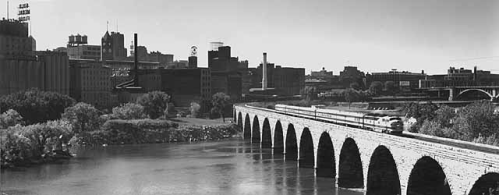Part 2: Community Members Receive AIA Minnesota Collaborative Achievement Awards
 Monday, October 3, 2022 at 2:01AM |
Monday, October 3, 2022 at 2:01AM |  Becky Fillinger |
Becky Fillinger |  Dan Collison
Dan Collison
Article by Becky Fillinger, photos provided
Dan Collison and Meghan Elliot are the recipients of this year’s AIA Minnesota Collaborative Achievement Award. They both have contributed much to the quality of our downtown physical environments, and they work collaboratively – which is the main criteria for the award. Our interview with Meghan Elliot was published October 1, and today we turn our attention to Dan Collison, Director of Business Development & Public Affairs for the Midwest at Sherman Associates.
Q: Congratulations on receiving the 2022 AIA Minnesota Collaborative Achievement Award! You’ve headed nonprofits, you are a minister, a great photographer and videographer, and do wonderful business development work. Were you surprised to have your many contributions acknowledged by an architectural association?
A: I was surprised, and yet feel honored to have been nominated by a cadre of architects who have both mentored me and collaborated with me and others across sectors on several downtown Minneapolis pro bono efforts over the last decade. I think they were inclined to nominate me because I have worked relentlessly, especially during the pandemic, to leverage all of my roles and skills to discern design solutions for not only the built environment and land use, but also public policy and community advocacy for downtown Minneapolis.
Q: The award committee noted your creative, sustained, and passionate service to the future of Minnesota communities. Could you tell us what you’re proudest of in working for the betterment of our communities?
A: Many colleagues and friends have seen my “card trick” over coffee or at a business happy hour or lunch. For almost eight years I have carried four business cards in my wallet: First Covenant Church of Mpls, East Town Business Partnership, NūLoop Partners and the Minneapolis Downtown Council-Downtown Improvement District. Each of these wonderful organizations has meant so much to me and are ultimately to be applauded for any and all accomplishments. For me personally, these are my favorites:
First Covenant Church: The East Town Apartments took more than five years and a lot of sweat and tears to bring 169 affordable units of housing to downtown and Elliot Park that now are home to nearly 300 new residents in the neighborhood.
 East Town Apartments, 618 S 9th Avenue
East Town Apartments, 618 S 9th Avenue
East Town Business Partnership: Navigating community convenings and partnerships while $3 billion in re-investment took place over six years of time. This brief video I filmed and produced tells the story of the relationships behind the scenes:
NūLoop Partners: The North Loop Root District organizing effort, taking place over three years with nearly 100 leaders from 50+ organizations and companies seeking to advance a holistic redevelopment framework for the Minneapolis Farmer’s Market area. This three-minute video nominated for an award by the American Institute of Architects tells the story:
The Minneapolis Downtown Council-Downtown Improvement District: The Chameleon Shoppes retail accelerator program advances diverse and locally owned small businesses in currently vacant retail. This multi-year effort was and still is herculean and beautiful. In the beginning I would say to myself and the pro bono leaders – “this project has a high chance of failure and a small chance of wild success.” I am so thrilled to have celebrated dozens of small moments of wild success! You can hear and see it in the voices and smiles of small business owners featured in this three-minute overview video:
Q: I’ve followed you for a couple of years and have noticed how you see projects through to completion. The awards committee noticed the same and called that out in giving you the award. Would you please tell us about the challenges in seeing complex projects through to completion?
A: The four projects listed above are the best examples of the vision, efforts, and follow through to completion on very large and complex projects requiring cross sector leadership and investment. Each project was wildly different than the other and yet the longitudinal time arc and developmental process of moving them from beginning to completion share a few common throughlines: 1) Noticing a serious and problematic gap or need in the downtown sector. 2) Gathering a host of stakeholders and thought leaders to map out issues and opportunities. 3) Creating a starting strategy framework and ultimate desired outcome for the project. 4) Implementing all strategies and aspirations with as much adaptability and relentlessness as I could summon in myself and draw out of others.
Q: What’s new on your horizon? How do we follow your always exciting news?
A: As of May 2022, I have been so pleased to join George and Chris Sherman, and the entire team at Sherman Associates to be their Director of Business Development & Public Affairs for the Midwest. Our corporate office has been and will continue to be in downtown Minneapolis at the historic JI Case Building. So, my passion and advocacy for the continued vibrancy and growth of an inclusive downtown will continue without disruption. And, now I have the privilege of working with many other cities and city centers across Minnesota and the Midwest to bring new housing and community impact projects that are for “all ages and all incomes.” Sherman Associates is a development firm with heart and purpose. I am really enjoying advancing those attributes while building out new relationships and project ideas with so many wonderful people in so many places. Mill City Times readers can follow me on LinkedIn. And, if people are interested in my videography efforts around human interest stories, they can connect with my YouTube Channel and my professional profile website.
Let’s stay in touch Mill City Friends!

































































